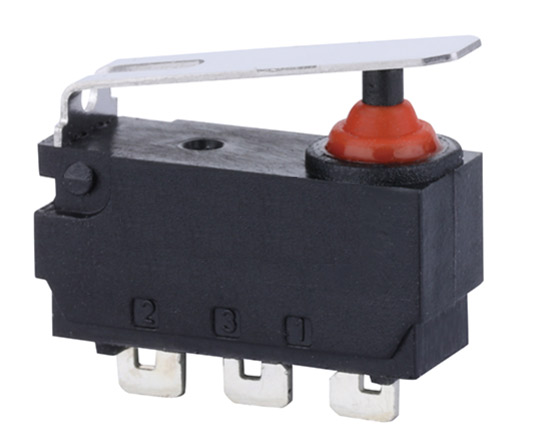Precision micro switches usually have three specifications: basic type, with operating handle, with operating handle and shell type. The micro switch adopts a push and spring design.
Whether engineers are looking for a thermostat for residential heating or industrial boiler control, or a level switch for a large oil tank, there are 5 key characteristics to consider: form factor, electrical requirements (voltage/current ), reliability (mechanical/electrical life), environmental factors (hazardous environments, temperature ranges), and agency approvals. The following 5 key steps will help you choose the right microswitch for your specific application.

Size matters when choosing a microswitch. Switch size is directly related to its characteristics, including current range, travel, and operating force. For example, one of the smallest microswitches on the market today measures 0.50" x 0.236" x 0.197" (LxWxH). While this tiny switch is suitable for detecting circuit conditions in compact circuit breakers, it typically only interrupts 0.1 to 3 amperes (A) and has a short stroke.
Applications that require higher currents typically require larger switches. For example, in a fuel tank application, the microswitch used to detect the liquid level needs to be able to provide a large stroke and withstand a large current. Usually in liquid level switch applications, the switch directly drives the water pump and carries a large current. This requires a large microswitch rated at 20A or 25A at 125VAC or 250VAC.
Tip: The smaller the size of the switch, the smaller the stroke and the current that can be interrupted.
In addition, the size of the switch also affects the operating force. Ideally, what engineers need is a switch with low operating force and high current capacity. But in fact a compromise is required between these two parameters. To maintain good contact while providing a large current carrying range, the microswitch requires a stronger spring, which increases the operating force and size of the switch. Operating forces can range from 2 grams in pressurized air-type applications to 8 ounces in solenoid valve applications (where higher operating forces are required). One of the largest switches on the market measures 1.94" x 0.69" x 1.3" (LxWxH).
Engineers should also pay attention to the differential travel of the switch—the distance between the switch's tripped position and its reset position. Its threshold will vary according to different applications. In temperature switch applications, for example, the on/off operating points should be as close as possible and the differential travel should be as low as 0.0001 inches. However, in the application of liquid level pump, if the differential stroke is too close, it may cause the make-up pump to start and stop too frequently, shortening the service life of the pump.
Two, understand the electrical requirements
Micro switches are usually capable of breaking currents from 5mA/5VDC to 25A/250VAC. The Micro Switch product line offers a range of products from low energy consumption to power load electrical types for a variety of applications.
Engineers must know the current and voltage ratings (AC or DC) required for a specific application to select the appropriate switch. As devices in all industries strive for low power consumption, microswitches must be able to operate at low currents (logic level loads) and DC voltages.
However, there are also applications that require switches capable of breaking high currents and voltages, such as industrial grade pump applications.
In addition to load requirements, engineers must select the appropriate circuit. The switch contacts must be one of normally open (NO) and normally closed (NC). For NO type contacts, normally no current flows between the contacts. When the switch is actuated, the contacts are closed and the circuit is connected. For NC type contacts, current flows between the contacts normally. When the switch is actuated, the contacts are opened and the circuit is disconnected.
Third, consider environmental conditions
Environmental requirements have a great influence on the selection of micro switches, especially in high reliability and critical applications such as industrial control and medical equipment. Understand the environmental conditions of the application, including contaminants in the air that may enter the switch, the liquid in which the switch is located, and operating temperature requirements.
For applications in harsh environmental conditions, you need to choose a sealed switch with a wide operating temperature range. Highly reliable microswitches can operate from -65 degrees Fahrenheit (-54 degrees Celsius) to 350 degrees Fahrenheit (177 degrees Celsius) for a variety of applications. At the same time, it should also be noted that the protection level of the switch should be at least IP67 to prevent liquid intrusion. This eliminates the need to spend a lot of time designing an enclosure that achieves the same degree of protection.
Fourth, clarify the requirements for working life
Switch reliability is critical. You need to determine how many electrical and mechanical operating lifetimes an application needs? Different switches have different contact materials, housings and terminals to meet the electrical and mechanical life requirements of different applications.
A highly reliable micro switch can operate 10 million to 20 million times before mechanical failure, and 50,000 to 100,000 times under maximum load before electrical failure.
As for the slight price difference between different quality switches, you need to consider the total cost of use. Because you're not only paying for the switch, you're also paying for the long-term, trouble-free operation of the switch. In many cases, the additional cost of using a more reliable switch is offset by a lower warranty cost during use.
V. Inspection agency certification requirements


